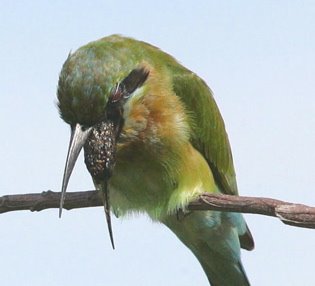Singapore has two species of bee-eater, Blue-tailed Bee-eater (Merops philippinus) and Blue-throated Bee-eater (M. viridis). The former is a very common winter visitor while the latter is a common resident but a rather uncommon winter visitor. These birds, as their names imply, specialise on bees, often caught on the wing. They also eat other insects of the same hymenopteran group as well as other groups of insects. But they seldom eat ground insects.
The bird normally perches on a high vantage point where it can keep a keen lookout for flying insects. Once it spots an insect, it sallies forth, catching and bringing it back to its perch to be processed. This involves striking it against the branch to stun it and rubbing it against a hard surface to remove the sting and venom sac. Once the insect has been properly processed, it is tossed in the air and immediately swallowed.
Bee-eaters regularly regurgitate pellets containing the indigestible remains of the insects they eat. It has been reported that the fresh pellet is blackish and about 1-3 cm long.
In an earlier posting I mentioned witnessing a Blue-tailed Bee-eater (Merops philippinus) regurgitating a pellet. Ardent birder, Cheong Weng Chun was quick to confirm, and so was Jianzhong Liu who sent an image of the bird in the act of pushing out a pellet from its mouth. By any account the image is awesome. I always find it interesting that photographers are the ones who notice and provide evidence of such details, not the normal birdwatchers. Why? Because photographers click, wait to click again and wait some more. And birders aim the binoculars, ID the bird and move away. The latter thus miss the most of the juicy aspects of bird watching. I have said before and I say it again. Birders should seriously think of becoming photographers…
In the meantime I have managed to obtain a series of images of the Blue-tailed Bee-eater caught in the act of casting a pellet. They are displayed here, courtesy of photographers Meng and Melinda Chan. Thank you both for agreeing to share with others your exciting series of images.


Meanwhile Jianzhong Liu has alerted me to a thread in a Taiwan forum on pellet casting by a shorebird.










2 Responses